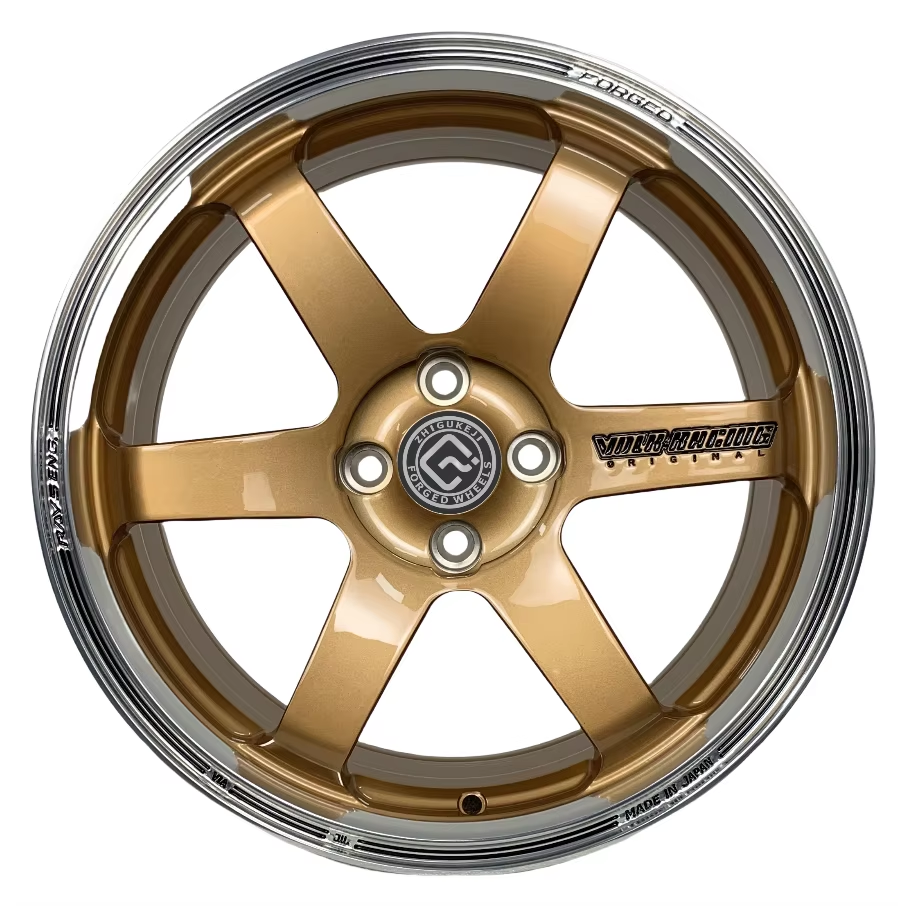The Engineering and Structure of 2 Piece Wheels
Understanding the anatomy of two-piece forged wheels: center section and removable barrel
A two piece wheel basically has two main parts forged aluminum for the central part where all the spokes go and then there's this separate barrel section usually crafted from lighter alloy materials. The central portion actually holds everything together it supports the spokes and connects right to the hub where all those suspension forces get transferred. Meanwhile the barrel part keeps that tire bead seated properly so it doesn't come loose during driving. What makes these wheels interesting is how manufacturers can play around with different materials. They'll make the center out of stronger forged metal since it takes most of the load, but save weight on the barrel sections because they don't need quite as much strength. With modern forging methods getting better all the time, companies can shape each component exactly how they want, resulting in wheels that last longer without sacrificing that perfect fit for specific vehicles.
How 2-piece wheel construction integrates strength, serviceability, and design flexibility
When the center connects to the barrel via bolts instead of being fused together, it makes repairs much easier. If something goes wrong with the barrel itself, mechanics don't have to throw away the whole wheel assembly just to fix one part. This modular approach cuts down on repair bills by around 30-35% when compared to those solid one piece wheels everyone used to install back in the day. The parts are machined with extreme accuracy and secured using high quality fasteners similar to what we see in aircraft manufacturing. Plus, because these components separate so neatly, shops can actually offer different width barrels tailored specifically for cars with staggered setups. And let's not forget about style either. Customers love mixing things up visually too. Some prefer their wheel centers polished to a mirror finish but want the barrels left with a more subtle matte look. Others go the opposite route. Either way, this separation opens up plenty of creative possibilities for customization.
Two-piece vs. one-piece wheel architecture: Key differences in performance and durability
Monoblock wheels are great for tracks because of how they're built as single pieces, but when it comes to everyday driving conditions, two piece setups actually handle impacts better. Tests on potholes revealed about 15 percent more resistance compared to monoblocks according to Tire Rack back in 2023. What makes this possible? The separate barrel part takes most of the hit when hitting curbs, protecting what would otherwise be a completely ruined wheel if it were all one piece. Forged versions of these two piece wheels weigh around 10 to maybe even 12 percent less than similar cast ones, which means the car's suspension can react faster while still holding up under normal loads. Looking at various studies about alloy wheels, we find they tend to stick around roughly 70% longer before showing signs of wear in places where rust is a big problem like coastal areas or regions that salt roads heavily during winter months.
Aesthetic Advantages of 2 Piece Wheels in Modern Vehicle Design
Enhancing Visual Depth and Presence with 2 Piece Wheels
The modular design separates the center from the barrel, enabling bold concave profiles and layered finishes that create dramatic light reflections and shadows. This depth adds 5–10% more visual mass compared to single-piece designs, making vehicles appear more planted and performance-oriented.
The Role of Concave Profiles in Amplifying Wheel Aesthetics
Deep concave spokes serve as focal points, highlighting geometric precision. A 2024 Wheel Design Study found that 73% of enthusiasts perceive concave 2 piece wheels as "more premium" than flat designs. The curvature also improves brake visibility—a key styling advantage for performance builds.
Real-World Case Studies: Custom 2 Piece Wheels Transforming Vehicle Styling
Customization has led to striking transformations. One restomod project combined polished aluminum barrels with brushed centers on a classic sports car, increasing social media engagement by 60% versus stock wheels. Off-road builds use contrasting finishes and colored hardware to accentuate lift kits and aggressive treads.
Balancing Aggressive Styling with Functional Performance
Today's two piece wheels combine bold looks with serious engineering behind them. The centers are precision forged which makes them more aerodynamic efficient so they cut through air better on highways, cutting down drag around 8% when driving fast. Those thick barrel flanges really hold up against curbs too, lasting about three times longer than regular cast wheels according to what I've seen in my time working with these things. Automotive engineers have been talking about how these wheels manage to look wild while still meeting that tough 100k mile durability mark that people who buy luxury cars demand from their wheels.
Customization and Fitment Flexibility of 2 Piece Wheels
Tailoring size, offset, and fitment to match vehicle dynamics
Two-piece wheels allow precise control over diameter, width, and offset, enabling optimal handling and compatibility with lowered suspensions, wide-body kits, or large brake systems. Proper clearance is maintained for calipers and suspension travel, ensuring functional fitment across diverse builds.
Modular design benefits: Swapping barrel widths and finishes for seasonal or stylistic changes
Owners can keep a single forged center and switch barrels seasonally—using narrow setups with all-season tires in winter and wider barrels with performance rubber in summer. Finish variations like matte, gloss, or machined accents allow visual refreshes without buying new wheels.
Interchangeability in 2 piece forged wheels: Cost-effective personalization options
Replacing only damaged outer barrels reduces long-term ownership costs by up to 40% compared to replacing entire one-piece wheels. This modularity also supports economical experimentation with staggered widths or lip depths, as only specific components require replacement.
Case study: One wheel set, multiple configurations – Maximizing versatility
A performance sedan owner used a single set of forged two-piece wheels for three distinct setups:
- Daily setup: 20x9" barrels with all-season tires
- Track setup: 20x10.5" rear barrels for wider summer rubber
- Show setup: Polished lips with color-matched centers
Industry experts confirm this approach reduces storage and cost while delivering tailored performance across driving conditions.
Design Innovation and Visual Impact Through Finishes
Radical Spoke and Deep-Lip Designs Enabled by 2 Piece Wheel Engineering
Modular construction allows aggressive spoke patterns with undercut details and deep-lip profiles exceeding 4 inches—unachievable with traditional casting. The separation of center and barrel maintains strength while enabling dramatic visuals, such as floating concave spokes spanning from hub to rim edge.
From Flush Fits to Staggered Setups: Expanding Aesthetic Possibilities
Two-piece technology enables exact fitment tuning for visual effect. Flush-mounted configurations create smooth transitions from tire to fender, ideal for EVs emphasizing aerodynamics. Staggered setups with wider rear barrels and adjusted offsets enhance muscular proportions in performance cars—a feature seen in 68% of modified sports cars (2023 wheel industry analytics).
Premium Finishes: Brushed, Polished, Matte, Chrome, and Multi-Tone Options
- Brushed finishes: Deliver scratch-resistant elegance for luxury vehicles
- Matte textures: Minimize glare while accentuating spoke geometry
-
Tri-coat powder processes: Achieve gradient effects like bronze-to-black
Recent advances in PVD (Physical Vapor Deposition) coatings provide triple the color durability of conventional paints, according to independent lab tests.
Matching Wheel Finishes to Vehicle Wraps and Brand Identity
High end auto shops have seen about 40% more customers wanting their wheel finishes to match full car wraps since around 2022. The two piece wheel design really works well for this trend because they can have different finishes on each part. Like maybe a matte black center paired with a shiny gold outer section that looks great against cars with two color paint jobs. Fleet operators are getting creative too, using colored lug nuts and special wheel covers so all their trucks look consistent even when they rotate out old ones for new models.
Performance Benefits That Complement Aesthetic Appeal
Weight savings and improved handling: The functional edge of forged 2 piece wheels
By separating the center and barrel, manufacturers reduce excess material in low-stress zones, cutting rotational mass. Forged 2 piece wheels weigh 18–22% less than cast one-piece equivalents, enhancing acceleration, braking, and suspension response—all without sacrificing visual appeal.
Data insight: 15% reduction in unsprung mass with 2 piece configurations (Tire Rack, 2023)
Independent testing confirms a 15% average reduction in unsprung mass with 2 piece forged wheels. Lower inertia improves directional control during cornering—critical for performance driving where rotating mass affects lap times. The design also reduces heat transfer from brakes to tires, minimizing thermal fatigue under hard use.
Long-term value through modular repairs and refurbishments
Damaged lips no longer necessitate full-wheel replacement. With two-piece wheels, owners replace only the barrel or refinish the center independently, saving $280–$400 per incident compared to one-piece repairs. Seasonal customization is equally practical—swap polished summer barrels for durable powder-coated winter variants using the same forged center.
FAQ
What are the main components of a two-piece wheel?
A two-piece wheel consists of a central section made from strong forged aluminum, which houses the spokes and connects to the hub, and a removable barrel, generally made from lighter alloy materials.
How do two-piece wheels improve serviceability and repair costs?
The two-piece design allows for the barrel to be replaced independently if damaged, reducing repair costs by 30-35% compared to one-piece wheels, as only the damaged part needs to be replaced.
What are the aesthetic advantages of using two-piece wheels?
Two-piece wheels allow for greater visual depth and customization options, like concave profiles and distinct finishes, which can enhance the visual mass and styling of a vehicle.
How does the weight of two-piece forged wheels compare to other types?
Forged two-piece wheels weigh 18–22% less than cast one-piece wheels, offering improvements in acceleration and handling due to reduced rotational mass.
Can barrel widths be altered for different driving conditions?
Yes, two-piece wheels allow for easy swapping of barrels, enabling owners to adjust the width and finish seasonally or according to driving needs.
Table of Contents
- The Engineering and Structure of 2 Piece Wheels
- Aesthetic Advantages of 2 Piece Wheels in Modern Vehicle Design
-
Customization and Fitment Flexibility of 2 Piece Wheels
- Tailoring size, offset, and fitment to match vehicle dynamics
- Modular design benefits: Swapping barrel widths and finishes for seasonal or stylistic changes
- Interchangeability in 2 piece forged wheels: Cost-effective personalization options
- Case study: One wheel set, multiple configurations – Maximizing versatility
- Design Innovation and Visual Impact Through Finishes
- Performance Benefits That Complement Aesthetic Appeal
-
FAQ
- What are the main components of a two-piece wheel?
- How do two-piece wheels improve serviceability and repair costs?
- What are the aesthetic advantages of using two-piece wheels?
- How does the weight of two-piece forged wheels compare to other types?
- Can barrel widths be altered for different driving conditions?




